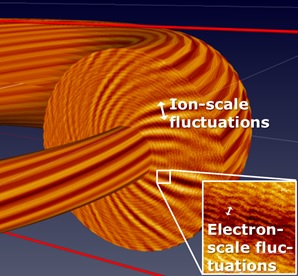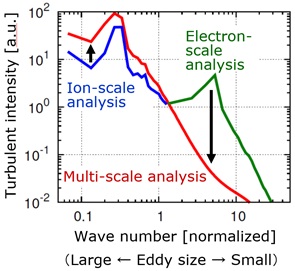
July 8, 2015
Nagoya University
Japan Atomic Energy Agency
National Institute for Fusion Science
A research group led by Assistant Professor Shinya Maeyama and Professor Tomohiko Watanabe from the Department of Physics (Dean: Kunihiro Matsumoto), Nagoya University, Principal Researcher Yasuhiro Idomura from Japan Atomic Energy Agency (JAEA), and Assistant Professor Akihiro Ishizawa from National Institute for Fusion Science (NIFS) discovered the mechanism of multi-scale interactions in fusion plasma turbulence by means of the supercomputer K.
A magnetic fusion reactor produces thermonuclear fusion power by confining high-temperature ionized gas (plasma) exceeding 100 million ℃ using a strong magnetic field generated by superconducting coils, and its development is promoted under international collaboration. Turbulence in magnetized plasma is one of the important research topics, because turbulent transport degrades plasma confinement. So far, most of fusion plasma turbulence research has been based on the scale-separation assumption between ion-scale turbulence and extremely fine electron-scale turbulence.
The research group, for the first time, realized multi-scale turbulence simulations, where ion- and electron-scale turbulence coexists, by fully utilizing the supercomputer K. As a result, they revealed the existence of multi-scale interactions, such as shearing of extremely fine electron-scale eddies by ion-scale turbulence and a damping effect of electron-scale turbulence on ion-scale laminar flows. It was also demonstrated that the plasma confinement performance may be influenced by these interactions.
This result is a new finding in plasma physics which demonstrates the violation of the scale-separation assumption, and contributes to the improvement of evaluation and prediction of plasma confinement performance in a fusion reactor. This work was conducted in collaboration between Nagoya University, JAEA, and NIFS, and was published in the Physical Review Letters on June 23rd, 2015.
The highest-resolution plasma turbulence simulation ever, which was realized by utilizing the supercomputer K, revealed the physical mechanism of multi-scale interactions between electron- and ion- scale turbulence in fusion plasma. Although scale-separation has been assumed between electron- and ion-scale turbulence, this work demonstrated that turbulence at different scales interacts with each other. This is a new finding in plasma physics and contributes to the improvement of estimation and prediction of plasma confinement performance in a fusion reactor.
·Plasma turbulence simulations at ultra-high resolution were achieved using the supercomputer K.
·Novel multi-scale interactions between electron- and ion-scale turbulence were discovered.
·The results contribute to the understanding of turbulent transport, which is one of the key issues in the development of a magnetic fusion reactor.
One keyword in this research is fusion. A magnetic fusion reactor is a device to confine plasma in a strong magnetic field generated by superconducting coils. In a plasma at temperatures exceeding 100 million ℃, energetic ions collide with each other to cause nuclear fusion reactions. In order to produce fusion energy from hydrogen isotope fuels in sea water and establish an energy source independent of fossil fuels and uranium, the development of a fusion reactor is promoted worldwide.
The other keyword is turbulence. Turbulence appears in various flows such as the atmosphere, rivers, oceans, and so on. High-temperature fusion plasma is no exception. Turbulence tends to transport and mix fluids, which often enhances homogenization. Large transport and mixing caused by plasma turbulence is unfavorable for a magnetic fusion reactor, because it degrades the plasma confinement.
It is known that there exist two types of plasma turbulence at different scales: ion-scale and extremely fine electron-scale turbulence. Since their spatiotemporal scales differ by a factor of a few tens to a hundred, most researches had assumed scale-separation between them.
The research group led by Assistant Professor Shinya Maeyama conceived that cross-scale interactions between electron- and ion-scale turbulence are possible via the merging and splitting processes of eddies in turbulence. Based on this idea, they studied multi-scale turbulence including both ion-scale and extremely fine electron-scale turbulence. For such an advanced analysis, a new simulation code had to be developed. Under the collaboration, the development of the code basis (NIFS), development of the massive parallelization algorithm (JAEA), and extension of the physical model (Nagoya University) were promoted, and finally enabled highly-accelerated and accurate analysis of the multi-scale turbulence. Then, by utilizing the supercomputer K, the highest-resolution plasma turbulence simulation ever was realized, employing 200 billion spatial grid points. The results demonstrate the existence of multi-scale interactions between ion- and electron-scale turbulence.
The remarkable physical results are:
·From ion-scale to electron-scale: suppression of electron-scale turbulence via the shearing effect of ion-scale turbulent eddies,
·From electron-scale to ion-scale: effective damping of ion-scale laminar flows via disturbance caused by electron-scale turbulence.
These results explain the physical mechanism of the multi-scale interactions. In addition, it was also revealed that these interactions affect the plasma confinement.
From the viewpoint of plasma physics, this innovative work demonstrates the violation of the conventional scale-separation assumption and the importance of the interactions between electron- and ion-scales. It pioneers the research of multi-scale interactions in plasma turbulence.
From the viewpoint of nuclear fusion research, the result makes a significant contribution to improving the evaluation and prediction of plasma confinement properties. Meanwhile, considering advanced applications such as device design and operation optimization, further research progress is required to clarify the conditions where electron-scale turbulence is important, and to construct a model for the estimation of turbulent transport without massive simulations.
Finally, from the viewpoints of fluid mechanics, it is characteristic phenomenon that small electron scale turbulence affects larger ion scale turbulence. The concept of energy cascade in neutral fluids, where large eddies break up into small eddies, is apparently not justified in plasma turbulence. Such a peculiar feature can be a clue to unravel elementary processes of turbulence.
This work was supported by MEXT KAKENHI Grant No. 26800283, and HPCI Strategic Program Field No. 4. The computations were carried out on the K computer at RIKEN AICS through HPCI System Research project (Project ID: hp120011), and on the Helios at IFERC-CSC. A part of the research was already presented and received international acclaim, the best poster award in the world largest HPC conference (SC13) and an oral (invited) talk in the IAEA Fusion Energy Conference.
A nuclear reaction in which two atomic nuclei collide and fuse to a nucleus. Fusion reaction of light nuclei, such as hydrogen, releases nuclear energy corresponding to mass defect.
In a high-temperature gas, atoms are dissociated into electrons and ions. This ionized gas is called a plasma.
A device using plasma to produce nuclear fusion energy.
Flows with irregular and changing flow velocities and pressures. Conversely, regular and organized flows are called laminar flows.
Interactions between two phenomena having different spatiotemporal scales. Scales of plasma turbulence created by electrons and by ions are respectively determined by the radius of typical particle trajectory, which are proportional to square root of mass. Thus, ion (hydrogen) scales are approximately 40 times larger than electron scales. In the text, the word multi-scale interaction implies the interactions between electron and ion-scale turbulence.
A computer with high-level computational capability and capacity for enormous amount of computing.
Japan’s fastest supercomputer at RIKEN AICS (as of June 2015).
A phenomenon observed in certain materials where electrical resistance becomes zero at low temperatures.
An assumption neglecting interactions between two phenomena having different spatiotemporal scales.
Title: Cross-scale interactions between electron- and ion-scale turbulence in a Tokamak plasma
Authors: Shinya Maeyama (JAEA, Nagoya University), Yasuhiro Idomura (JAEA), Tomohiko Watanabe (Nagoya University), Motoki Nakata (JAEA, NIFS), Masatoshi Yagi, Naoaki Miyato (JAEA), Akihiro Ishizawa, Masanori Nunami (NIFS)
Journal: Physical Review Letters
Article number: Vol. 114, No. 5, 255002
Date: 23 June 2015
URL: http://link.aps.org/doi/10.1103/PhysRevLett.114.255002
DOI: 10.1103/PhysRevLett.114.255002

Fig. 1 Simulation result obtained from the supercomputer K. Turbulent electrostatic potentials are shown on a cross-sectional surface of a torus plasma. Large ion-scale fluctuations and small electron-scale fluctuations coexist (shown in the magnified picture). Although two separate scale fluctuations are clearly distinguishable in this figure, they tend to mix and evolve into a complex turbulent state due to the multi-scale interactions.

Fig. 2 Effect of multi-scale interactions on a turbulence fluctuation spectrum. Compared to conventional single-scale analysis of ion- and electron-scale turbulence (blue and green), multi-scale analysis (red) shows suppression of electron-scale fluctuation intensity and enhancement of ion-scale turbulence.
[ BACK ]